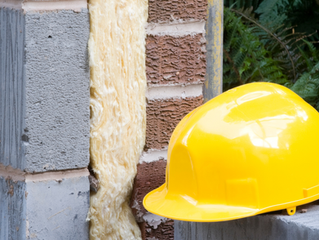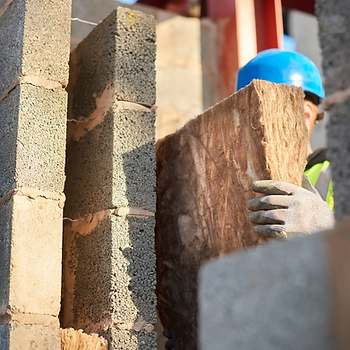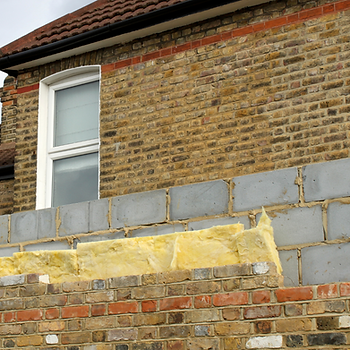Are you aware that many UK homes, particularly those built before 2012, may not be as energy-efficient as they could be?
Free cavity wall insulation grants are here to change that, potentially offering a solution to improve your home’s energy efficiency.
In this article, we’ll explore everything you need to know about cavity wall insulation, the significant impact it can have on your home’s comfort and energy costs, and how you might be eligible for free cavity wall insulation.
Why is Cavity Wall Insulation Crucial for UK Homes?
Cavity wall insulation is an essential measure for UK homeowners looking to enhance their home’s warmth, reduce energy bills, and increase the property’s overall value.

This type of insulation is installed between the gaps in the walls (the cavities), which can be a significant source of heat loss in many homes. By filling these gaps, you can retain more heat during cold months, leading to a cosier home environment and lower heating costs.
How Does Cavity Wall Insulation Work?
Cavity wall insulation is a technique used to improve the energy efficiency and thermal performance of buildings by insulating the gap between the internal and external walls. Here’s a detailed look at the process:
Inspection: The first step involves inspecting the cavity walls to determine their suitability for insulation. This includes checking for any existing damp issues or structural defects that need addressing before insulation can be installed.
Choosing Insulation Material: The insulation material used in cavity walls can vary. Common materials include mineral wool, polystyrene beads, and urea-formaldehyde foam. The choice depends on factors like thermal performance, cost, and the specific characteristics of the building.
Installation Process: Professional installers typically use a small drill to make holes in the external wall. These holes are spaced strategically to ensure even distribution of the insulation material.
Injecting the Insulation: The chosen insulation material is then injected into the cavity through the drilled holes. Specialized equipment is used to ensure that the material fills the entire cavity, leaving no gaps.
Sealing and Finishing: After the cavity is filled, the drilled holes are carefully sealed to match the external wall, ensuring that the appearance of the building is not adversely affected.
Performance Improvement: Once installed, the cavity wall insulation acts as a barrier, reducing the amount of heat lost through the walls. This can significantly reduce the need for heating and cooling, leading to lower energy bills.
Protection Against Elements: Besides improving thermal efficiency, cavity wall insulation also offers protection against external elements, reducing the chances of dampness and improving the overall comfort of the building.
Cavity wall insulation is an effective method for enhancing the energy efficiency and comfort of both residential and commercial buildings. It is especially beneficial in older buildings, where wall insulation may not have been a consideration during the original construction.
The Many Benefits of Cavity Wall Insulation For UK Homeowners
By opting for cavity wall insulation, homeowners can enjoy a warmer, more energy-efficient living environment.
Cavity wall insulation is a key home improvement for many UK homes, offering numerous advantages. Here are the primary benefits:
Improved Energy Efficiency
Cavity wall insulation greatly enhances a building’s thermal performance by reducing heat loss through the walls. This leads to decreased heating and cooling costs, offering an efficient way to reduce energy bills.

Enhanced Thermal Comfort
With cavity wall insulation, homes can maintain more consistent and comfortable indoor temperatures year-round. This reduces the occurrence of cold spots and drafts, creating a more pleasant living environment.
Reduced Carbon Emissions
By lowering the energy required for heating and cooling, cavity wall insulation plays a significant role in reducing the carbon footprint of a building, contributing to sustainability and a more eco-friendly approach to construction.
Increased Property Value
Cavity wall insulation can increase a property’s value by improving its energy efficiency. This enhancement can make a building more appealing to potential buyers or tenants, potentially leading to higher resale or rental values.
Protection Against Weathering
The insulation serves as a barrier against external elements, protecting the walls from weather-related damage such as moisture and temperature fluctuations. This helps extend the lifespan of the building’s structure.
Condensation Control
Improving the thermal performance of walls with cavity wall insulation helps prevent the buildup of condensation, which can lead to dampness and mold problems.
Sound Insulation
Depending on the insulation material used, cavity wall insulation can also provide better sound insulation, reducing the intrusion of external noise.
Minimal Disruption
As cavity wall insulation is installed within the walls, the process causes minimal disruption to the occupants. The home’s interior remains mostly unaffected during installation.
Compliance with Building Regulations
Installing cavity wall insulation often helps buildings meet or exceed energy efficiency standards and building regulations, ensuring compliance with local codes.
Overall, cavity wall insulation is a cost-effective and sustainable solution for improving the energy performance, comfort, and durability of your home, while also providing economic and environmental benefits.
The Power of Government Energy Efficiency Incentives
The average cost of cavity wall insulation in the UK is between £3200 for a detached property and £2400 for a bungalow. It’s also possible to get cavity wall insulation for a flat and this will cost in the region of £980.
The UK government is actively encouraging energy efficiency improvements and has introduced various grants and initiatives to support this endeavor. The importance of these incentives is evident in several key areas related to cavity wall insulation:
Funding Assistance
Government grants provide crucial financial support for homeowners undertaking cavity wall insulation projects. This assistance eases the monetary burden, making energy-efficient upgrades more accessible to a broader range of homeowners.
Reduced Energy Consumption
Cavity wall insulation allows homeowners to significantly decrease heat loss through their walls, leading to a marked reduction in energy usage. The result is lower monthly energy bills, offering homeowners the chance to save money over time and achieve greater economic stability.

Environmental Benefits
Implementing cavity wall insulation is a proactive step towards better energy efficiency, reducing the need for excessive heating. This decrease in energy demand lowers harmful emissions, enabling homeowners to contribute meaningfully to environmental sustainability by reducing their carbon footprint.
Property Value Enhancement
Incorporating energy-efficient improvements like cavity wall insulation can improve a property’s energy efficiency rating and overall attractiveness. This can potentially increase the property’s value, making it more appealing to potential buyers or renters.
Overall, government incentives play a crucial role in promoting free cavity wall insulation, transforming homes into more comfortable, cost-effective, and environmentally friendly spaces.
What Energy Grants Are Available For Free Cavity Wall Insulation?
For homeowners interested in free cavity wall insulation, there are several government grants available to explore. This article highlights a key initiative: the Energy Company Obligation, commonly known as ECO, managed by Ofgem and supported by the UK government.
Understanding the ECO Scheme
The ECO scheme is focused on making UK homes more energy-efficient, prioritising those in greatest need, such as low-income or vulnerable households. Major energy companies are obligated under this scheme to assist in improving the energy efficiency of these homes, which is particularly beneficial for residents in colder, less efficient properties.
Spotlight on ECO4
The latest phase of this scheme is ECO4, with a primary objective of reducing carbon emissions and aiding those facing high heating costs. Essentially, ECO4 serves as a home energy-efficiency makeover, aiming to make homes warmer and more cost-effective to maintain.
Key Aspects of ECO4:
Energy Efficiency Goal: The main purpose is to enhance the energy efficiency of homes and help homeowners make savings on energy bills.
Target Homes: ECO4 primarily targets homes that do not use gas for heating and instead rely on alternatives like oil, electric boilers, or solid fuels.
Eligibility Based on EPC Rating: Homes with an Energy Performance Certificate (EPC) rating of D or higher may not qualify for ECO4. However, those with lower ratings, such as F or G, could be eligible. ECO4 aims to improve these homes’ EPC ratings to at least a D.
Homeowner and Tenant Eligibility: Both homeowners and private tenants who meet specific criteria could receive a grant covering the cost of cavity wall insulation or other energy-saving measures.
Potential for Full Coverage: Qualifying individuals might receive substantial financial assistance, potentially covering the entire cost of the insulation.
To begin the process, interested parties should contact a company specialising in energy-saving grants and fill out a form. Energy-saving experts can determine eligibility and may arrange a free home survey to enhance its cosiness and energy efficiency through cavity wall insulation.
Do I Qualify For a Government Grant For External Wall Insulation?
Many UK residents have the opportunity to obtain free cavity wall insulation through the Energy Company Obligation (ECO4) scheme. You may qualify for a full grant that covers installation costs if you meet certain criteria:
Health Conditions
If a member of your household has a long-term health condition such as asthma, diabetes, arthritis, or limited mobility, and is under medication, you will need to provide a letter from a GP confirming this.
Low Income
Households with a total annual income of less than £31,000 may be eligible. For self-employed individuals, this figure refers to net profit rather than gross turnover.
Receiving Benefits
Your household might qualify for cavity wall insulation grants if any resident receives one or more of the following benefits:
- Tax Credits
- Universal Credit
- Housing Benefit
- Child Tax Credits
- Working Tax Credit
- Pension Credit
- Income Support
- Income-Related Employment & Support Allowance
- Income-Based Job Seekers Allowance
- Child Benefits (depending on the total income of your household).
ECO4 presents an excellent chance for homeowners, particularly those on lower incomes, to enhance their homes’ energy efficiency and reduce their carbon footprint. This scheme, by providing financial assistance for improvements such as free cavity wall insulation, is aiding the UK in its journey towards cleaner and more sustainable energy use. It also addresses critical issues like fuel poverty, making it a valuable resource for many.
Can I Get Free Cavity Wall Insulation If I Don’t Receive Benefits?
The encouraging news is that eligibility for free cavity wall insulation extends beyond those currently receiving specific benefits. LA Flex, an extension of the ECO4 scheme, empowers local authorities to support households falling into particular categories.

It’s important to verify if LA Flex is offered in your council area. You might qualify for external wall insulation grants under the following conditions:
Low-Income Status: Your household’s low income and potential vulnerability to fuel poverty could make you eligible.
Property Characteristics: If your home faces heating challenges due to poor insulation or lacks a central heating system, this could qualify you for the grant.
Vulnerable Individuals: The presence of elderly individuals, persons with disabilities, or families with young children in your household could also make you eligible for these grants.
How Can I Apply For Free Cavity Wall Insulation?
Applying for cavity wall insulation grants through the Energy Company Obligation (ECO) scheme, specifically the ECO4 phase, is designed to be a straightforward process. Here’s a breakdown of how the ECO4 application process typically unfolds for cavity wall insulation:
Eligibility Assessment
Your first step is to complete an eligibility assessment form to determine if you qualify for ECO4. This assessment mainly focuses on factors relating to your home’s energy performance, rather than your receipt of government benefits.
Submission of Application
Next, you will need to fill out the application forms. This can be done on your own or with the assistance of a designated company. The forms generally require information about your home, such as energy usage and eligibility based on your home’s energy performance.
Evaluation and Approval
After submitting your application, it will be reviewed thoroughly to ensure it meets ECO4 criteria. A key part of this phase is a free assessment of your home’s energy efficiency, pinpointing the most advantageous improvement measures, like cavity wall insulation.
Implementation of Energy Efficiency Measures
Once your application is approved, your energy supplier will arrange for the installation of the energy efficiency measures – in this case, cavity wall insulation. Notably, if you meet the criteria, you won’t have to cover the upfront costs of these improvements.
Validation and Inspection
After the insulation is installed, there may be an inspection to ensure that the work complies with the required standards.
Experience the Benefits of Free Cavity Wall Insulation
Once the installation is complete and has passed any necessary inspections, you’ll be able to start enjoying the benefits of the energy efficiency improvements. This includes potential reductions in your energy bills and the option to integrate renewable energy sources, such as solar panels, into your home.
Cavity Wall Insulation: Frequently Asked Questions
Do I need planning permission for cavity wall insulation?
Generally, planning permission is not required for cavity wall insulation. However, if your property is in a conservation area, a national park, an area of outstanding natural beauty, or is a listed building, you should check with your local council as specific rules may apply.

Is cavity wall insulation suitable for any property?
Cavity wall insulation is appropriate for many properties, especially those built after the 1920s which typically have cavity walls. It’s suitable for both existing properties and new builds, but it’s important to first confirm that your property has cavity walls.
How long does cavity wall insulation installation take?
The installation of cavity wall insulation is relatively quick, often completed in just a few hours to a day, depending on the size of the house. Unlike external wall insulation, it requires less preparation and no scaffolding, speeding up the process significantly.
What is the installation process for cavity wall insulation?
The process involves drilling small holes in the external walls of the property and injecting the insulation material into the cavity. After the insulation is installed, the holes are sealed to match the existing wall as closely as possible. Prior checks are conducted to ensure there are no pre-existing issues, like damp, that could affect the effectiveness of the insulation.
Does cavity wall insulation require much maintenance?
Cavity wall insulation is very low maintenance. Once installed, it’s hidden within the walls and does not require any regular upkeep. However, it’s important to ensure that there are no issues such as dampness in the walls before installation, as this can affect the insulation’s performance.
Apply For Free Cavity Wall Insulation Today
Government grants for cavity wall insulation offer an excellent opportunity for homeowners to make their homes more energy-efficient and eco-friendly.
These grants, including the Energy Company Obligation (ECO4) scheme and other related initiatives, significantly lower the financial barriers associated with installing cavity wall insulation.
Tapping into these incentives allows homeowners to improve their properties’ energy efficiency, reduce heating costs, and contribute to a more sustainable future.
Apply today by completing our form below. We can take you through the application process and help you to secure funding for free cavity wall insulation.


